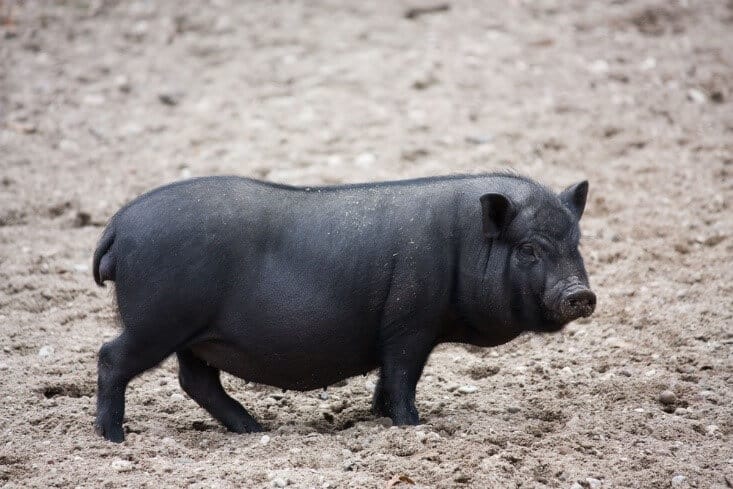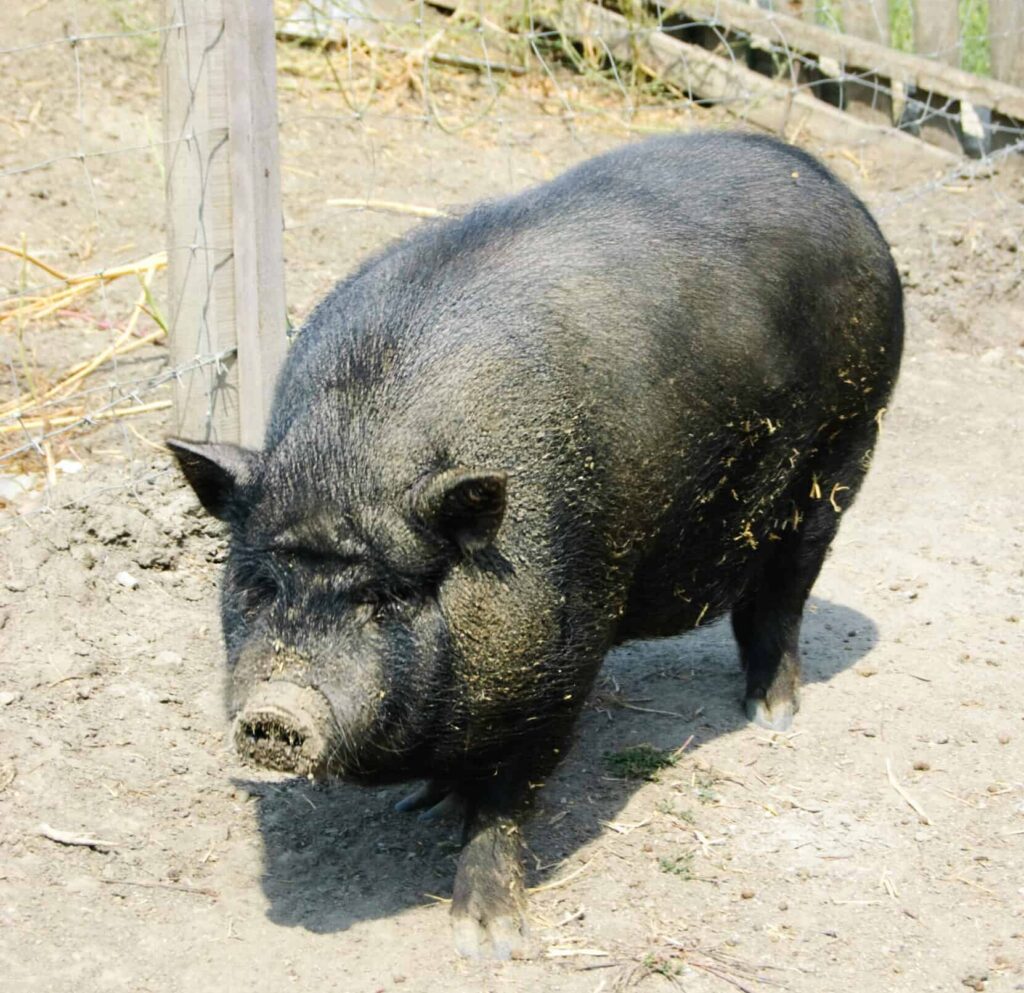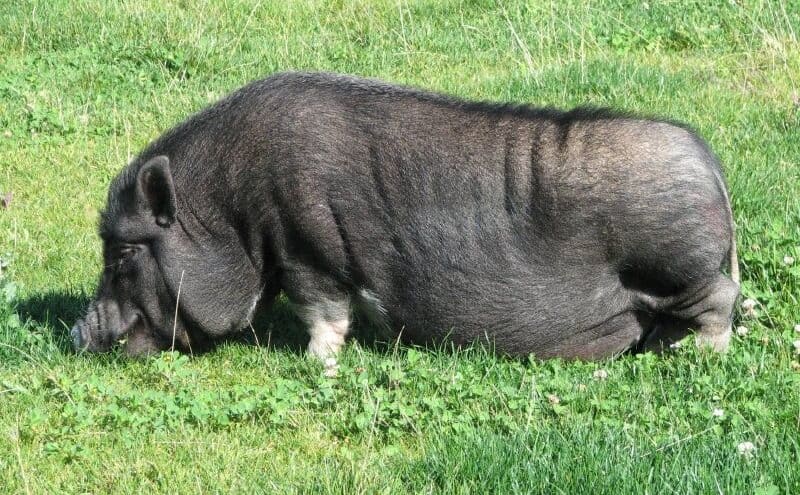Here is what to know about raising a Vietnamese potbelly pig, whether you are interested in them for meat, pets, or both. Many hobby farmers raise them for meat because of their smaller size.
This breed is overall more manageable because they are smaller than standard farm pigs. Vietnamese potbellies are friendly and intelligent, making them attractive pets as well.
Whether you want to raise a Vietnamese potbellied pig as a pet or livestock, it can be a wonderful addition to your homestead. Please know, while smaller, they still grow to be around 200 pounds and need proper care.
Keep reading to learn more about Vietnamese Potbelly pigs, including reasons to raise them, what to know about their care, physical characteristics, origins, and more.
Why Keep a Vietnamese Potbelly Pig?
There are several reasons to consider keeping a Vietnamese Potbellied pig.
- Small-scale meat production
- Take up less room than standard farm pigs
- Eat less than larger-sized pigs
- Can be more manageable for new pig owners raising them for meat
- Make good pets despite not being too fond of being carried and petted
- They are intelligent and friendly
They are easy to care for as ordinary farmyard pigs. Depending on the quality of your land, they can find some of their own food, just like pasture pigs, but it’s best to supplement to ensure they are getting the necessary nutrition.
This breed isn’t used for commercial meat production because of their size and because they grow more slowly than standard breeds.
Important to Know If You Raise Them
If you are keeping female and male pigs, you might need to consider housing the boars away from the sows. Once a male pig reaches an older age, they can grow tusks which can put the female pigs in danger.
They are often called “mini pigs” but please know, they aren’t tiny, teacup pigs. While Vietnamese Potbellied pigs are the smallest recognized breed of pig and smaller than standard pig breeds, they still grow to be upwards of 100 lbs.
Pigs are social animals. They will do much better being raised with other pigs than alone.
Pigs like mud and also will root around on other of your property for food. Be sure to provide them for areas for their natural rooting behaviors. At the very least, they will need rooting mats.
A Vietnamese Potbelly piggy can be a good companion that is not only docile in nature but also compassionate. If you keep these animals as pets, you will need to provide them with:
- Suitable living quarters
- Area for them to root in soil or provide rooting mats
- Need a managed diet to avoid obesity
- Enough space to play around
- Dedicate a bit of your time and energy to them

Vietnamese Potbelly Pig Appearance & Characteristics
Considered a small pig breed or a mini pig breed, adult potbellied pigs hardly ever get to the same size as other larger breeds. That is probably one of the main reasons why most people get these pigs as pets. However, they don’t always stay small, cute, and cuddly as they age.
Another issue with this approach is that, unlike dogs and cats, pigs aren’t predators; they are prey. They don’t always like being picked up or handled by people. This kind of restraining behavior can cause them anxiety.
Color
The Vietnamese Potbelly pig tends to have black skin that comes with sparse hair. However, some breed varieties have a solid white color, and some have a variety of spots.
Body Composition
As the name suggests, the potbellied pig has a potbelly. This descended belly can sometimes get so large that it scrapes the ground while the pig is standing. This is especially true for pregnant sows. This pet pig has loose skin that has wrinkles, and if you find one that’s purebred, it will most likely have a straight tail.
Potbelly pigs have a short snout. Despite this, they have an incredible sense of smell.
As a mini pig, the Vietnamese potbelly pig breed is smaller than American and European farm pigs. Fully grown, they typically grow to about 15 inches tall at the shoulders and 3 feet long. On average, they weigh about 70 – 170 pounds with the males growing heavier than the females.
Behavior
For the most part, pigs tend to be docile creatures. However, Vietnamese Potbelly pigs have a wide range of moods and behaviors. A female pig often tends to be quite moody or aggressive. Even more so if they are pregnant.
An intact male or boar can produce a foul smell and become aggressive without warning. This is particularly true when it’s in the presence of sows or female pigs. It is recommended that you spay or neuter a potbelly pig if you decide to keep it as a pet.
Diet
These pigs can be kept as pasture pigs since they like rutting with their snouts in the dirt or among leaves for different food items such as roots and insects. Being omnivorous, Vietnamese Potbelly pigs like eating:
- Leaves
- Roots
- Stems
- Flowers
- Fruits
- Eggs
On occasion:
- Small reptiles
- Amphibians
- Insects
Learn more about what do pigs eat. Since they have such a varied diet, these pigs tend to be quite hardy.
Lifespan
Wild pigs have a lifespan of about 10 years because they face many threats, mostly due to their size. Even though wild boars have tusks, their miniature size doesn’t give them that many advantages against predators.
Potbellied pigs in the care of humans, however, tend to live much longer. Their typical age range is from 15 to 20 years.

Reproduction
In pigs, neutered male pigs are called barrows, while intact male pigs are called boars. A female pig that has never given birth to piglets is called a gilt, while those that have given birth are called sows.
Vietnamese Potbelly boars and sows become fertile at the tender age of 5 to 6 months. This is long before they can be considered physically mature for breeding.
When it comes to giving birth to piglets, potbelly pigs are unpredictable. They can give birth to as little as one piglet or they can have ten or more. It all depends on their genetics (including the boars) and nutrition. This pig breed is pregnant an average of 114 days.
Vietnamese Potbelly Pig History
Potbellied pigs have been around for over 40,000 years. The Vietnamese potbelly pig in North America can trace its roots to the “Lon I” breed from the Red River Delta in Vietnam. The locals originally bred these domestic pigs for their meat.
Scientifically known as Sus scrofa domesticus, the Vietnamese Potbelly pig is a dwarf swine breed like many of the miniature pig breeds found on farms across the globe.
If you are a pig farmer in North America, there’s a good chance that the Vietnamese Potbellied pig you have on your farm is part of the breed developed in the 1960s. These pigs were originally brought into Canada and Sweden before being imported into the country.
Originally imported for the zoo, the Vietnamese Potbelly pig was brought into the country by Keith Connell, a Canadian who didn’t intend to breed them but to supply them to local zoos.
During this process, a private buyer who fell in love with the miniature pigs bought them as pets, and that’s how the worldwide popularity and distribution of these adorable pigs began.
FAQs
How big do Vietnamese potbelly pigs get?
They are smaller pigs, weighing 100 – 200 pounds versus over 600 pounds for standard farm pigs. Sometimes they are called mini pigs or miniature pigs because they are smaller.
What is the purpose for raising Vietnamese Potbelly pigs?
Many hobby farmers raise Vietnamese Potbelly pigs for meat. Being smaller, they eat less, take up less space, and can be overall more manageable to raise. People also raise them as pets.
Are Vietnamese potbelly pigs the same as teacup pigs?
No, Vietnamese potbellies are not teacup pigs. Examples of small pigs, like the Juliani or Kunekune pigs, typically weigh 75 to 150 pounds when fully grown. This is much larger than “teacup-sized”. However, sellers often advertise them as being smaller. Full-grown Vietnamese Potbelly pigs are larger, weighing up to 200 pounds.
Can you eat Vietnamese potbelly pigs?
Yes, many hobby farmers raise them in backyards for a sustainable source of meat. Standard farm pig breeds used for meat, such as Yorkshire, Hampshire pig, or Duroc, can weigh 600 to 800 pounds vs up to 200 pounds for Vietnamese potbellies.
Are there different types of potbelly pigs?
Yes, there are different varieties of potbelly pigs. These include different sizes and colors. However, they all mostly have characteristic compact appearance (a potbelly) with short legs.
What is the temperament of a potbelly pig?
Potbelly pigs considered intelligent and social. You should definitely raise at least two pigs together to keep them thriving. They enjoy rooting around, playing in mud, and having human interaction.
How do you tell if a pig is a potbelly pig?
You can tell if a pig is a potbelly pig because it has a compact body, short legs, and potbelly stomach that hangs low.
Do potbelly pigs have any health concerns?
Because they are small and slow-growing means they can be a target of predators. Have a secure space for them, especially at night.
In a farmyard setting, they are easy to care for and don’t have any notable health concerns. It’s also important to have them regularly checked by a vet to ensure they are in good health. This is particularly important for pregnant sows.
Are Vietnamese Potbelly pigs easy to domesticate?
The predominant potbelly pig breeds in North America are domestic pigs. This means that if purchase a potbelly pig, it will likely already be domesticated. In Vietnam, there are a lot of wild potbelly pigs that aren’t as easy to domesticate, but it can be done with the right degree of patience and crossbreeding.
How long do potbelly pigs live?
In the wild, they hardly ever go past their 10th year. Domesticated Vietnamese Potbelly pigs can live up to 20 years, though there are factors that affect pig lifespan.

